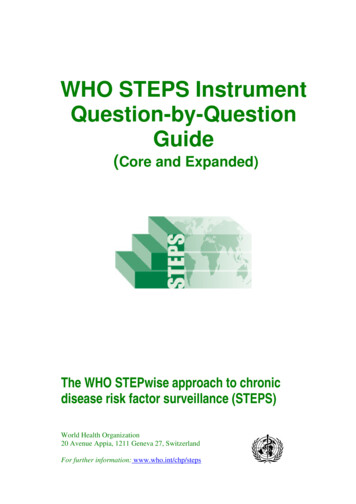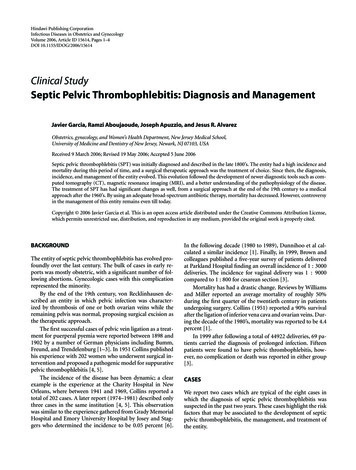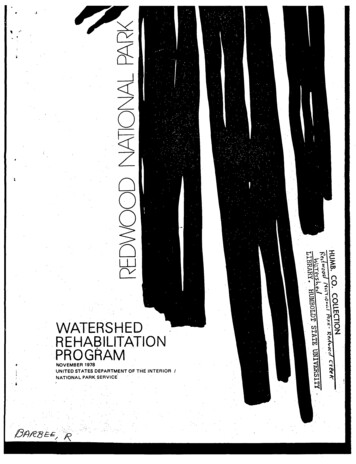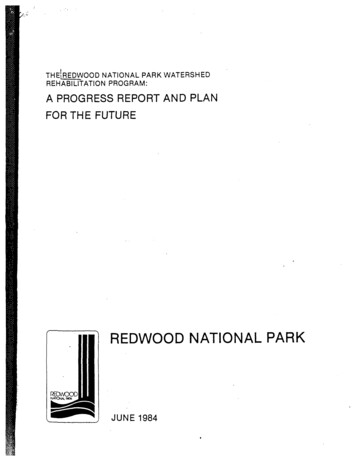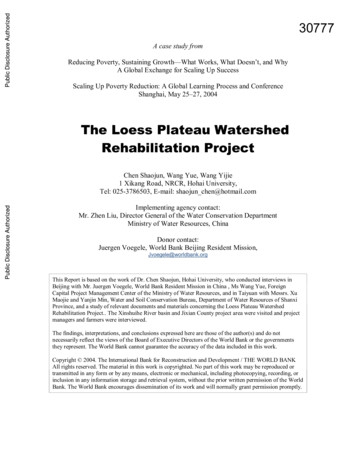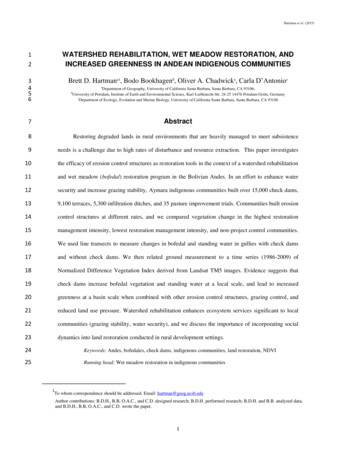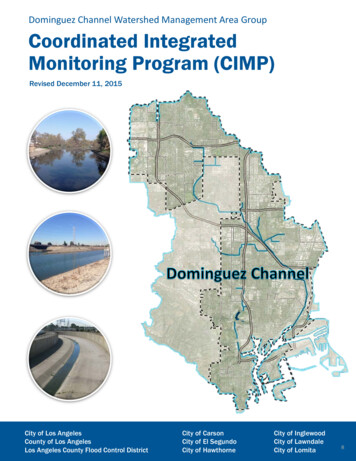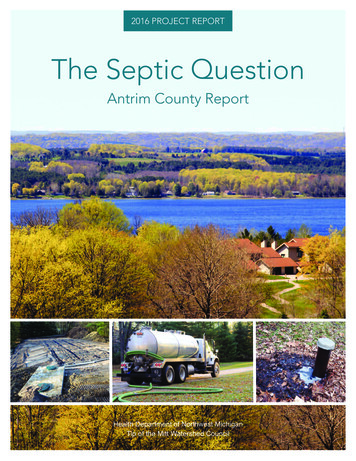
Transcription
2016 PROJECT REPORTThe Septic QuestionAntrim County ReportHealth Department of Northwest MichiganTip of the Mitt Watershed Council
Health Department of Northwest Michigan and Tip of the Mitt Watershed CouncilThe 2016 Antrim Septic Question Report is funded by a grant from the Joyce Foundation
TABLE OF CONTENTSExecutive Summary 1The Septic Question Project Report1. Introduction . 32. Background . 43. The Sanitary Code .64. Elk River Chain of Lakes. . .75. Statement of the Problem . .116. Policy Options to Consider . .14A. Maintain the Status Quo 15B. Time of Transfer Inspection Ordinance . 16C. Mandatory Pumping Ordinance .20D. Mandatory Inspection Ordinance 24E. Pilot Program, Overlay District, and Septic Maintenance District .277. Conclusion .28Appendix A 29Appendix B . 30Appendix C 32Appendix D 33Appendix E 34TABLES AND FIGURESTable 1. Domestic wastewater phosphorus contribution bydifferent sources in a household . .9Table 2. Antrim County Population .9Table 3. Health Department Sewage Treatment and Disposal System(STDS) inspections, Milton Township 10Figure 1. System Age of Residential System Failures – 2013 12Figure 2. Years Between Pumping . 21
The goal of theproject is to closelyexamine septicsystem policies forthe entire watershed,identify any problems,and examine potentialways to solve them.
THE SEPTIC QUESTION PROJECT REPORT:Antrim County - Executive SummaryThe Septic Question Project is a grant partnership between the Health Department of NorthwestMichigan and Tip of the Mitt Watershed Council, funded by the Michigan Department ofEnvironmental Quality. The goal of the project was to closely examine septic system policiesfor the entire Lake Charlevoix watershed, identify any problems, and examine potential waysto solve them. The committee was also charged with creating a Final Report for decisionmakers. However, as the project unfolded, it became obvious that this information wouldbe useful to other watersheds, so we created additional versions. This is the 2016 AntrimCounty version of the Septic Question Project Final Report, which includes specific policyoptions to consider, in order to best protect the Elk River Chain of Lakes, Grand TraverseBay, and other lakes and streams in these watersheds.Statement of the Problem: Most on-site septic systems in the state are never inspectedagain, once installed. Michigan is the only state in the nation without uniform standards forhow on-site septic systems are designed, built, installed, and maintained. Public healthofficials in Michigan believe reported septic system failures represent only a fraction of thetotal number of failures statewide, and many go undetected or remain unreported for years.In most counties in Michigan, after a system is built, the counties do not follow up to makesure those systems are functioning properly. Only 11 counties out of 83 in Michigan have arequirement for septic inspections, and those are during the transfer or sale of property.Because this important follow up is non-existent in the other 72 counties, it creates a potentialthreat to public health and water resources. To further support this point, as recently as June2015, brand new research was published in the Proceedings of the National Academy ofSciences of the United States of America. The study, conducted by Michigan State University,used microbial source-tracking tools to show that pollution arising from septic systemdischarges is likely much more severe than previously realized. Results suggest human fecalcontamination is affecting 100% of the studied river systems in Michigan’s Lower Peninsula.Key Findings: This Final Report includes a simple analysis that demonstrates potentiallymore than one third of the aging septic systems in Antrim County have not been replaced.Considering that typical septic systems usually have a lifespan of 25 to 30 years, those oldersystems still in use may have already failed, or could be on the verge of failing soon. We wantto see changes that require additional oversight to ensure failing systems are discoveredbefore they fail completely. Research and data collection point to warning signs that we cantake into account, in support of making changes to oversight requirements.Therefore, we created a menu of Policy Options for decision makers to consider and tohelp get the discussion started in the community. Our intent is to make positive changethat is not punitive or burdensome for citizens, businesses, and local governments. WeANTRIM COUNTY1
researched what is working in other areas of Michigan and the US and interviewedindividuals in charge of implementing those policies. This report summarizes each policyoption, provides interview responses, and outlines the Advantages and Disadvantages foreach of the following: Maintain the Status QuoTime of Transfer Inspection OrdinanceMandatory Pumping OrdinanceMandatory Inspection OrdinanceWe also address the use of a Pilot Program, where appropriate, and Overlay Districts. Finally,the Health Department is also currently seeking to update the Sanitary Code in a paralleleffort, which the Watershed Council supports.2Septic Question Project Report
THE SEPTIC QUESTION PROJECT REPORT1. INTRODUCTIONThis Project Report presents research related to the topic of on-site septic wastewaterdisposal and treatment systems (septic systems), with a special focus on local concerns.Citizens and local officials in Antrim, Charlevoix, Cheboygan, and Emmet Counties are interestedin this topic, and some local governments are expressing concern and asking for help. TheHealth Department of Northwest Michigan and Tip of the Mitt Watershed Council are involvedin these discussions. This regional Health Department covers Otsego, Antrim, Emmet, andCharlevoix Counties. District Health Department #4 covers Cheboygan County, and aCheboygan version this report will be shared with them as well.Originally, the Health Department of Northwest Michigan and the Watershed Council weregrant partners in The Septic Question Project for the Lake Charlevoix Watershed, funded bythe Michigan Department of Environmental Quality (MDEQ). We convened local stakeholdersto form the Project Committee (participants listed in Appendix A). This report contains theoriginal committee findings, and adds Antrim County-specific information for this version ofthe Final Report. The Antrim County work is funded by the Joyce Foundation.The Watershed Council and the Health Department will conduct events in Antrim County to sharethis report with local governments and citizens in order to begin the conversation in thecommunity. We will also form a Project Committee to engage stakeholders on the topic.We will reach out to the Elk River Chain of Lakes (ERCOL) Watershed Plan ImplementationTeam (WPIT) to create a Project Committee, and invite local government representatives,related business representatives, and citizens at large to participate, as well. The ERCOL-WPITis also writing a brand new watershed management plan for the ERCOL, and these Projectefforts will be incorporated into the new plan.Research for this report was conducted by the Watershed Council from summer 2015 throughfall 2016 for the expressed purpose of helping local governments and other interested partiesto closely examine septic systems, related to both public health and water resource protection.Later in the report, we present a menu of policy options for consideration by citizens andlocal decision makers. For readers who need a short primer on septic system mechanics,please consult Appendix B.Finally, we note that there is more to the septic “system” than what the property ownermanages. Remember, the property owner system is pumped, and when the truck drives awaywith the contents of your septic tank, they are going somewhere. There are only two choicesfor where it goes, in Antrim County: either land application or a wastewater treatment plant.This extremely important part of the “system” should also be considered during communityconversations and debate. Both choices are backed by science, but both have their limitsand those limits must be confronted, for us to continue to protect local water resources. Theseptic pumping business sector has many challenges, moving forward, and public policydecisions about septic system oversight must take these challenges into account.1Jeff Alexander, “Michigan has nation's weakest regulations on septic systems,” Bridge Magazine(May 12, 2013; updated May 14, 013/05/ michigan has nations weakest r.html, accessed online August 2015.ANTRIM COUNTY3
2. BACKGROUNDDespite being surrounded by the Great Lakes and blessed with thousands of inland lakesand streams, Michigan is the only state in the nation without uniform standards for howon-site septic systems are designed, built, installed, and maintained. According to theMDEQ Environmental Health Section, a state code would be a benefit, in terms of managingseptic systems after they are constructed. That is because in Michigan, after a system is built,counties do not follow up to make sure those systems are functioning properly, with very fewexceptions.1 Because this important follow up is non-existent in most places, it creates adistinct threat to public health and water resources.Importantly, as recently as June 2015, brand new research was published in the Proceedingsof the National Academy of Sciences of the United States of America. The study, conductedby Michigan State University (MSU), used microbial source-tracking tools to show that pollutionarising from septic system discharges is likely much more severe than previously realized. Dr.Joan Rose, one of the authors of the study, noted, “All along, we have presumed that on-sitewastewater disposal systems, such as septic tanks, were working. But in this study, sampleafter sample, bacterial concentrations were highest where there were higher numbers of septicsystems in the watershed area.”2Bacteroides thetaiotaomicron (B. Theta) is a human source-tracking marker. The MSU studycovered 64 rivers that drain 84% of Michigan’s Lower Peninsula. These rivers were sampledunder baseflow conditions for B. Theta, E. coli, landscape characteristics, and geochemicaland hydrologic variables. The study abstract noted that “In particular, watersheds with morethan 1,621 septic systems exhibited significantly higher concentrations of B. Thetaiotaomicron.”In the Results and Discussion section, the study states, “The B. theta results suggest humanfecal contamination was affecting 100% of the studied river systems. These results havesignificant implications for water and environmental quality managers.”3Michigan-specific research such as this provides incentive for us to address septic systemswith new urgency. Northern Michigan currently enjoys high quality waters, but what is theoutlook if we ignore these warnings? Tip of the Mitt Watershed Council is currently involvedin discussions in Lansing to urge action on a statewide code, which was tried in 2004. Wewill continue with this effort, but realistically, a statewide code could be many years in themaking, if it happens, at all. In the absence of a statewide code, Michigan has local SanitaryCodes created by local district health departments, in conjunction with county governments.As such, local government is the best hope for taking action to address local concerns aboutseptic system performance. Additionally, if a successful model for local government actionon septic systems is designed, it could serve as a model for consideration by statewide policymakers, who will eventually address this topic. We hope they address effective statewide oversightfor septic systems as a proactive measure, rather than 15 or 20 years from now, as a reactionto fouling waters.Jeff Alexander, “Michigan has nation's weakest regulations on septic systems,” Bridge Magazine (May 12, 2013; updated May 14, 013/05/michigan has nations weakest r.html , accessed online August 2015.2“Septic Tanks aren’t keeping poo out of rivers and lakes,” Michigan State University news (August 3, ks-arent-keeping-poo-out-of-rivers-and-lakes/ accessed August 2015.3Marc P. Verhougstraete, Sherry L. Martin, Anthony D. Kendall, David W. Hyndman, and Joan B. Rose, “Linking fecal bacteria in rivers to landscape, geochemical, and hydrologicfactors and sources at the basin scale,” Proceedings of the National Academy of Sciences of the United States of America, (June 29, 2015, pages 1-2). Obtained using PNASwebsite: sid df386024-ecd7-4f06-a0b4-e55720db3950 accessed September 2015.14Septic Question Project Report
In the meantime, local government is charged with maintaining general health, safety, andwelfare. In Northern Michigan, special emphasis is placed on healthy drinking water, plushigh quality surface water and public areas devoted to recreational use. Antrim, Emmet,Charlevoix, and Cheboygan Counties all have significant areas with no public wastewatercollection and treatment system. In some locations, this means there is a potential for watersupplies to be threatened by failing septic systems. Statewide examples of this exist. Accordingto a Marquette County permitting database, between 2009 and 2012, almost 40 percent ofseptic systems being replaced were actively failing to the ground surface. These failed systemswere only discovered because property owners were willing to voluntarily contact the healthdepartment.4Additionally, a study was conducted by Washtenaw County after passing a county ordinancein the year 2000, requiring inspection of wells and septic systems at the time of the sale of aproperty. For inspections conducted over the first 18 months, the study showed: 18% of the septic systems inspected were failing or inadequate One out of every 18 septic systems (5.5%) had an illicit discharge5The term "failure" in Washtenaw County is defined as follows, for septic systems and wells:1) the backup of sewage into a structure; 2) discharge of effluent onto the ground surface; 3)the connection of an OSDS to a storm drain; 4) liquid level in the septic tank above the outletinvert; 5) structural failure of a septic tank; 6) discharge of sewage into any stream or otherbody of water; 7) the liquid level in a disposal field above the outlet holes in the pipe of suchfield; 8) unsafe water sample; 9) substantial nonconformance with water well constructionrequirements; 10) substantial nonconformance with water well isolation from contaminationsource requirements.6Section 12752 of the Michigan Public Health Code, Act 368 of 1978, was written to establishthe need for public sewer systems. It is included here because it highlights some of the problemswith septic systems. This section of the health code states:“ Septic tank disposal systems are subject to failure due to soil conditions or other reasons. Failure or potential failure of septic tank disposalsystems poses a threat to the public health, safety, and welfare; presentsa potential for ill health, transmission or disease, mortality, and economicblight; and constitutes a threat to the quality of surface and subsurfacewaters of this state "7We are duty-bound to address this issue in Michigan.Brad Neumann, “Got Water? Time of sale septic inspections can protect water quality: Part 1,” Michigan State University Extension website posted October 6, 2015,http://msue.anr.msu.edu/news/got water time of sale septic inspections can protect water quality part 1, accessed November 2015.5Washtenaw County website, eWashtenaw, Time Of Sale (TOS) tments/environmental health/wells septic/eh owsdshome.html; accessed November 2015.6Washtenaw County website, eWashtenaw, TOS Regulation, definitions, nvironmental health/wells septic/eh owsdsreg.html;accessed December 2015.7Michigan Legislature website, Public Health Code (Excerpt) Act 368 or 1978, sikul5tn4pv33eqm51xnu%29%29/mileg.aspx?page getobject&objectname mcl-333-12752&query on&highlight 12752accessed December 17, 2015.4ANTRIM COUNTY5
3. THE SANITARY CODEAntrim, Charlevoix, and Otsego counties are covered by the same local code. That originalSanitary Code was passed in 1966, and it has been amended several times since then. TheHealth Department of Northwest Michigan is responsible for implementing the SanitaryCode, and they also implement a separate code for Emmet County. However, the currentproposal to revise the code also attempts to consolidate the two codes, creating a singlecode including Emmet. In order to make that happen, it must be approved by the Board ofCommissioners for all four counties. As noted earlier, District Health Department #4 coversCheboygan County, and a version this report will be shared with them.By law, the Health Department of Northwest Michigan is REQUIRED to inspect septic systemsin Antrim County in ALL of the following circumstances:1 – according to the Sanitary Code (details below)2 – during a time of transfer of property in Milton Township, Antrim County3 – if a citizen complains4 – if another government agency makes a referral5 – if related to the beach programIf the Health Department discovers that any of the prohibited acts from the Sanitary Codeare occurring, they inspect the system and take actions to correct the violation. If they areconducting a Milton Township Time of Transfer inspection or mortgage evaluation, theyrequire that the tank be pumped, or the owner must produce a pump statement dated within5 years, according to the Milton ordinance. As noted above, the Health Department alsoinspects when they receive complaints, and those can come from citizens or from otheragencies, who also may be requesting technical assistance, for various reasons. During thesummer beach monitoring programs, septic inspections could also be required if it looks likea system is contributing to public beach contamination problems. Before requiring pumpingfor inspection, the Health Department does a file review, to determine system specifications. Theyalso confirm capacity, general construction specifications, and other important specifications.8However, there are no requirements for regular inspections of existing septic systems,beyond what has been described. This means that most systems are never inspected again,once installed. If homeowners are not educated about their septic system, it is possible thatthey will not have it maintained properly, resulting in problems for waterways and sometimesfor neighbors. Additionally, as we will outline in a simple analysis, aging systems have notbeen replaced, are probably uninspected and unmaintained, and thus are in danger of failing.However, even newer systems that are uninspected can need repairs, and that could meanthe difference between an affordable fix and polluting the Chain of Lakes.Additionally, there are problems with the Appeals Board process under the current sanitarycode. We noted that many code violations have been permitted during the appeals process,and that is not helpful for providing the type of strong water protection needed to keep the86Health Department of Northwest Michigan, Director Scott Kendzierski, email/phone interview, September 11, 2015.Septic
Bacteroides thetaiotaomicron (B. Theta) is a human source-tracking marker. The MSU study covered 64 rivers that drain 84% of Michigan’s Lower Peninsula. These rivers were sampled under baseflow conditions for B. Theta, E. coli, landscape c
